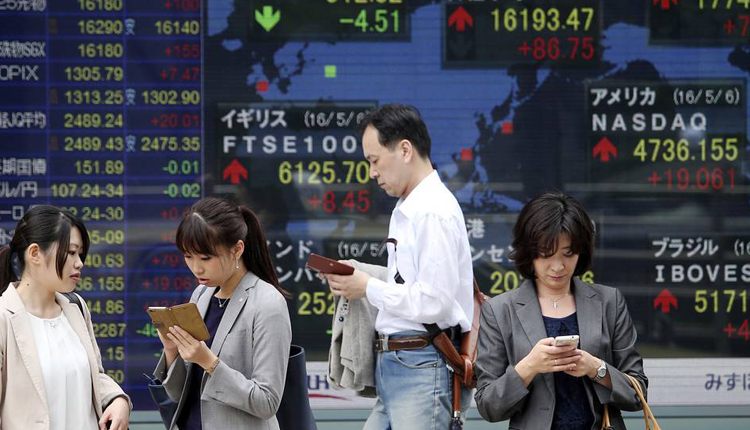Asian stock markets fell Monday following an escalation in the U.S.-China trade war late last week.
Hong Kong’s Hang Seng index led losses in the region as it dropped more than 2%, as of its final hour of trading, following another weekend of violent protests in the city.
Mainland Chinese stocks also saw declines on the day. The Shanghai composite shed 1.17% to about 2,863.57 and the Shenzhen component slipped 0.98% to 9,270.39. The Shenzhen composite fell 0.768% to approximately 1,566.57.
Elsewhere, the Nikkei 225 in Japan dropped 2.17% to close at 20,261.04, while the Topix index declined 1.61% to end its trading day at 1,478.03. That came despite Japanese Prime Minister Shinzo Abe’s recent agreement on the principles of a trade deal with U.S. President Donald Trump.
Losses were also seen over in South Korea, where the Kospi fell 1.64% to close at 1,916.31. Australia’s S&P/ASX 200 finished its trading day 1.27% lower at 6,440.10.
Overall, the MSCI Asia ex-Japan index declined 1.56%.
US-China trade war heats up
Trump said Monday that China called U.S. negotiators on Sunday to say they wanted to negotiate, following a recent escalation in the trade war between Washington and Beijing.
Trump tweeted last Friday that America will hike tariffs on $250 billion worth of Chinese goods to 30% from 25%. Tariffs on another $300 billion in Chinese products will also go up to 15% from 10%, Trump said. The levies on the $250 billion worth of goods are scheduled to kick in Oct. 1, while the duties on the $300 billion are set to go into effect in two stages on Sept. 1 and Dec. 15.
At the G-7 summit over the weekend in France, Trump said he regrets not raising tariffs even higher, adding that he could declare the U.S.-China trade war a national emergency.
Beijing unveiled new tariffs last Friday on $75 billion of U.S. goods. That was in response to Trump’s surprise announcement earlier this month that the U.S. would impose duties on another $300 billion of Chinese goods — some of these items have since been delayed to December or removed from the list.
“This tit-for-tat escalation shows how unlikely a trade deal and de-escalation have become,” Louis Kuijs, head of Asia economics at Oxford Economics, wrote in a note. “It is now unlikely that the existing and planned trade restrictions will be removed any time soon, while other kinds of restrictions may also be introduced.”
Markets stateside were sent tumbling last Friday after Trump ordered U.S. firms to “start looking for an alternative to China,” with the Dow Jones Industrial Average plunging more than 600 points.
“In the last 20 years, U.S. corporates have built big positions in China,” Richard Martin, managing director at IMA Asia, told CNBC’s “Squawk Box” on Monday.
He added that American businesses are now “nervous on two levels.”
“It’s not only what Trump might do with his emergency powers, it’s the response that you’ll get in China,” Martin explained. “Not necessarily just the response from the government, it’s the response from ordinary people and companies in China who might say ‘the U.S. firms are no longer our friend.’”
Chinese yuan slips, oil prices fall
Amid the market turmoil, the offshore Chinese yuan fell to a record low against the dollar. It last traded at 7.1510. Its onshore counterpart was at 7.1418 against the greenback after the People’s Bank of China (PBOC) set the official midpoint reference at 7.0570 per dollar.
“We haven’t really seen any strong signal that the PBOC is trying to stabilize the market,” Frances Cheung, head of macro strategy in Asia at Westpac Banking Corp, told CNBC’s “Street Signs” on Monday.
“In general ,the dollar-CNY has already passed the 7 level, 7.10 level, so all these burdens are out of the way. So in theory, there is a higher flexibility for the (yuan) to just follow market forces,” Cheung said.
The Japanese yen, often viewed as a safe-haven currency during times of market turmoil, traded at 105.78 against the dollar after touching an earlier high of 104.44.
The U.S. dollar index, which tracks the greenback against a basket of its peers, was at 97.791 after seeing levels above 98.0 for much of last week. The Australian dollar changed hands at $0.6758 after slipping from highs above $0.678 the previous trading week.
Oil prices were mixed in the afternoon of Asian trading hours, with international benchmark Brent crude futures recovering from an earlier slip to rise just above the flatline to $59.36 per barrel and U.S. crude futures dropping 0.15% to $54.09 per barrel.
source: CNBC
